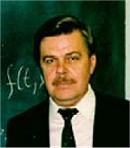|
Plenary
Lecture
Hidden Oscillations in Dynamical Systems

Professor Gennady A. Leonov
Co-authors: G. A. Leonov, N. V. Kuznetsov, S. M.
Seledzhi
St. Petersburg State University
Universitetsky pr. 28, St. Petersburg, 198504
Russia
E-mail:
leonov@math.spbu.ru
Abstract: The problem of hidden oscillations in
nonlinear control systems forces to develop new
approaches of nonlinear oscillation theory. During
initial establishment and development of theory of
nonlinear oscillations in the first half of 20th century
a main attention has been given to analysis and
synthesis of oscillating systems for which the solution
of existence problems of oscillating regimes was not too
difficult. The structure itself of many systems was such
that they had oscillating solutions, the existence of
which was "almost obvious". The arising in these systems
periodic solutions were well seen by numerical analysis
when numerical integration procedure of the trajectories
allowed one to pass from small neighborhood of
equilibrium to periodic trajectory. Therefore main
attention of researchers was concentrated on analysis of
forms and properties of these oscillations (the "almost"
harmonic, relaxation, synchronous, circular, orbitally
stable ones, and so on).
Further there came to light so called hidden
oscillations – the oscillations, the existence itself of
which is not obvious (which are "small" and, therefore,
are difficult for numerical analysis or are not
"connected" with equilibrium i.e. the creation of
numerical procedure of integration of trajectories for
the passage from equilibrium to periodic solution is
impossible). So in the midpoint of twentieth century
M.A.Aizerman and R.E.Kalman formulated two conjectures,
which occupy, at once, attention of many famous
scholars.
Similar situation is in attractors localization. The
classical attractors of Lorenz, Rossler, Chua, Chen, and
other widely-known attractors are those excited from
unstable equilibria. From computational point of view
this allows one to use numerical method, in which after
transient process a trajectory, started from a point of
unstable manifold in the neighborhood of equilibrium,
reaches an attractor and identifies it. However there
are attractors of another type: hidden attractors, a
basin of attraction of which does not contain
neighborhoods of equilibria.
In this presentation the application of special
analytical-numerical algorithms for hidden oscillations
and hidden attractor localization are discussed.
Construction of counterexamples for Aizerman's and
Kalman's conjectures, and existence of hidden attractor
in Chua's systems are demonstrated.
Brief Biography of the Speaker:
Gennady A. Leonov received his PhD (Candidate Degree) in
mathematical cybernetics from Saint-Petersburg State
University in 1971 and Dr.Sci. in 1983.
From 1985 – he is full professor at the Mathematics and
Mechanics Faculty. He has been vice-rector of
Saint-Petersburg State University from 1986 to 1988.
Now Gennady A. Leonov is Dean of Mathematics and
Mechanics Faculty (since 1988), Director of Research
Institute of Mathematics and Mechanics of St.-Petersburg
State University (since 2004), Head of Applied
cybernetics Department (since 2007).
Professor G.A. Leonov was awarded Prize of
St.-Petersburg State University (1985), State Prize of
USSR (1986), Prize of Technische Universitet Dresden
(1990).
He is member (corresponding) of Russian Academy of
Science, member of the Russian National Committee of
Theoretical Mechanics, member of Directorate of
St.-Petersburg Mathematical Society.
Professor G.A. Leonov authored and co-authored 300 books
and papers. His research interests, now in qualitative
theory of dynamical systems, stabilization, nonlinear
analysis of phase synchronization systems and electrical
machines.
|
